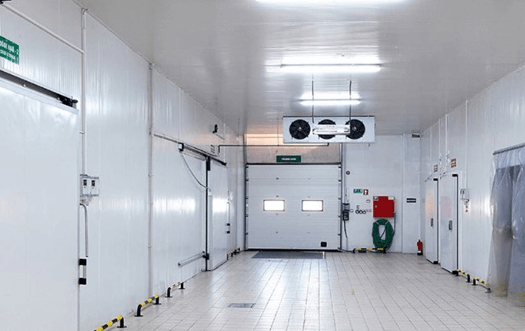
The experiments carried out in the 90's, gave Fruit Control Equipments the initial impulse for the study and elaboration of a new technology that represented the evolution of the controlled atmosphere and successively UO formulae. By that time, taking advantage of the experience gained, and improving the initial technology. The Blueice India method corresponds to a cycle repeated over time of the initial oxygen stress phase followed by the ULO phase, placing great attention on the CO² concentration variations inside the store based on the variety of the fruits, combined with some quality control tests on the stored product. The Blueice India project application requires above all optimal gas tightness and should be applied in cells containing the same variety of apple When loading the fruit into the cells, a representative sample of the various lots inside the cell of 8-10 crates must be placed in front of the hatch each containing 3-5 apples from each lot. During the stress period, quality control checks should be taken out for samples. The successive gas stress periods and their conditions are decided on the basis of analytical results with particular reference to the apples ethanol content which may be carried out with an easy to use a kit by the fruit warehouse technician or Fruit Quality Control manager.
CO2-scrubbers are used to manage the CO2 levels in the cool cell. Air from the storage area is removed by the scrubber, and the CO2 purified air is then fed back in.
With a CA scrubber (also known as a nitrogen generator or separator), the fruit can be quickly brought under CA conditions once the space has been filled or after a connecting door, for example, has been opened
Fruit varieties that are sensitive to ethylene (under CA conditions), require an ethylene converter. The ethylene converter from BLUE ICE removes ethylene from the cool cells using catalytic combustion; ethylene can thus be maintained at any required level.
A control system measures and registers O2 and CO2 and operates the CO2 and O2 scrubbers. In addition, the same control system can regulate cooling (switching on/off, defrosting, machine room regulation), carry out ethylene measurements and operate the ethylene converter.
Fruit that is stored in a CA/ULO cell always loses moisture. This moisture loss reduces if the RH levels (relative humidity) are kept above 90%. Cooling takes water out of the atmosphere, thus limiting the storage period and quality. A humidification system means that relative humidity can be kept up to scratch.
CO2-scrubbers are used to manage the CO2 levels in the cool cell. Air from the storage area is removed by the scrubber, and the CO2 purified air is then fed back in.
Finally, the CA cool cell is also fitted with a couple of accessories that are vital for VA storage; - a flexible buffer (also called a ‘lung’) absorbs pressure differences in the cool cell without oxygen streaming into the cell. - under and over pressure valves ensure that larger pressure differences (which cannot be accommodated by the air buffer) are evened out so that the cool cell is not damaged.
The main barriers to airtight storage structures appear to be their high initial cost as well as the cost of air-tightening structures to an acceptable level.
Controlled environments prevent some taste development while slowing ripening and maintaining firmness.
They are essential to quality control because they allow food to be transported without significantly increasing the number of microorganisms.
Because they serve to extend the shelf life of fresh items, cold rooms are crucial.
When fossil fuels are used, carbon dioxide is released into the atmosphere.